1938 FIFA World Cup
The 1938 FIFA World Cup was the third edition of the World Cup, the quadrennial international football championship for senior men's national teams and was held in France from 4-19 June 1938. Italy defended its title in the final, beating Hungary 4–2. Italy's 1934 and 1938 teams hold the distinction of the sole World Cup champions under the same coach, Vittorio Pozzo.
| Coupe du Monde 1938 | |
|---|---|
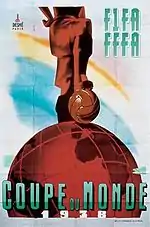 Official poster | |
| Tournament details | |
| Host country | France |
| Dates | 4–19 June |
| Teams | 15 (from 4 confederations) |
| Venue(s) | 10 (in 9 host cities) |
| Final positions | |
| Champions | |
| Runners-up | |
| Third place | |
| Fourth place | |
| Tournament statistics | |
| Matches played | 18 |
| Goals scored | 84 (4.67 per match) |
| Attendance | 374,835 (20,824 per match) |
| Top scorer(s) | |
Host selection
France was chosen as host nation by FIFA in Berlin on 13 August 1936. France was chosen over Argentina and Germany in the first round of voting. The decision to hold a second consecutive tournament in Europe (after Italy in 1934) caused outrage in South America, where it was believed that the venue should alternate between the two continents. This was the last World Cup to be staged before the outbreak of the Second World War.
Qualification
Because of anger over the decision to hold a second successive World Cup in Europe, neither Uruguay nor Argentina entered the competition. Spain meanwhile could not participate due to the ongoing Spanish Civil War.
It was the first time that the hosts, France, and the title holders, Italy, qualified automatically. Title holders were given an automatic entry into the World Cup from 1938 until 2002 (inclusive), since abolished.
Of the 14 remaining places, eleven were allocated to Europe, two to the Americas, and one to Asia. As a result, only three non-European nations took part: Brazil, Cuba and the Dutch East Indies. This is the smallest ever number of teams from outside the host continent to compete at a FIFA World Cup.
Austria qualified for the World Cup, but after qualification was complete, the Anschluss united Austria with Germany. Austria subsequently withdrew from the tournament, with some Austrian players joining the German squad, although not including Austrian star player Matthias Sindelar, who refused to play for the unified team.[1] Latvia was the runner-up in Austria's qualification group, but was not invited to participate; instead Austria's place remained empty, and Sweden, which would have been Austria's initial opponent, progressed directly to the second-round by default.
This tournament saw the first, and as of 2018 the only, participation in a World Cup tournament from Cuba and the Dutch East Indies (now Indonesia). It also saw the World Cup debuts of Poland and Norway. Romania would not qualify for another World Cup until 1970, Poland and the Netherlands would not reappear at a finals tournament until 1974, and Norway would not qualify for another World Cup finals until 1994. A unified Germany team would not appear again until 1994, although Austria returned in 1954 and won third place.
List of qualified teams
The following 16 teams originally qualified for the final tournament. However, 15 teams participated after Austria's withdrawal due to the Anschluss.
|
|
Format
The knockout format from 1934 was retained. If a match was tied after 90 minutes, then 30 minutes of extra time were played. If the score was still tied after extra time, the match would be replayed. This was the last World Cup tournament that used a straight knockout format.
Summary
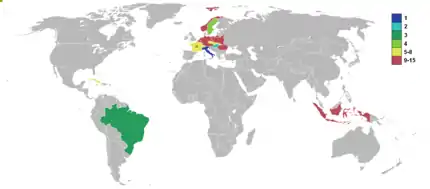
Germany, France, Italy, Czechoslovakia, Hungary, Cuba and Brazil were seeded for draw taking place in Paris, on 5 March 1938. Sweden was given a bye due to Austria's withdrawal.[2]
Five of the seven first round matches required extra time to break the deadlock; two games still went to a replay. In one replay, Cuba advanced to the next round at the expense of Romania. In the other replay, Germany, which had led 1–0 in the first game against Switzerland, led 2–0 but eventually was beaten 2–4. This loss, which took place in front of a hostile, bottle-throwing crowd in Paris, was blamed by German coach Sepp Herberger on a defeatist attitude from the five Austrian players he had been forced to include; a German journalist later commented that "Germans and Austrians prefer to play against each other even when they're in the same team".[3] Until they were knocked out in the first round in 2018, this was the only time Germany had failed to advance past the first round for 80 years.[4]
Sweden advanced directly to the quarter-finals as a result of Austria's withdrawal, and they proceeded to beat Cuba 8–0. The hosts, France, were beaten by the holders, Italy, and Switzerland were seen off by Hungary. Czechoslovakia took Brazil to extra time in a notoriously feisty match in Bordeaux before succumbing in a replay; the South Americans proved too strong for the depleted Czechoslovak side (both Oldřich Nejedlý and František Plánička had suffered broken bones in the first game) and won 2–1. This was the last match to be replayed in a World Cup.
Hungary destroyed Sweden in one of the semi-finals 5–1, while Italy and Brazil had the first of their many important World Cup clashes in the other. The Brazilians rested their star player Leônidas confident that they would qualify for the final, but the Italians won 2–1. Brazil topped Sweden 4–2 for third place.
Rumour has it, before the finals Benito Mussolini was to have sent a telegram to the team, saying "Vincere o morire!" (literally translated as "Win or die!"). This should not have been meant as a literal threat, but instead just an encouragement to win. However, no record remains of such a telegram, and World Cup player Pietro Rava said, when interviewed, "No, no, no, that's not true. He sent a telegram wishing us well, but no never 'win or die'."[5]
The final itself took place at the Stade Olympique de Colombes in Paris. Vittorio Pozzo's Italian side took the lead early, but Hungary equalised within two minutes. The Italians took the lead again shortly after, and by the end of the first half were leading the Hungarians 3–1. Hungary never really got back into the game. With the final score favouring the Italians 4–2, Italy became the first team to successfully defend the title and were once more crowned World Cup winners.
Because of World War II, the World Cup would not be held for another 12 years, until 1950. As a result, Italy were the reigning World Cup holders for a record 16 years, from 1934 to 1950. The Italian Vice-President of FIFA, Dr. Ottorino Barassi, hid the trophy in a shoe-box under his bed throughout the Second World War and thus saved it from falling into the hands of occupying troops.[6]
Venues
Eleven venues in ten cities were planned to host the tournament; of these, all hosted matches except the Stade de Gerland in Lyon, which did not due to Austria's withdrawal.
| Colombes (Paris area) |
Marseille | Paris | Bordeaux |
|---|---|---|---|
| Stade Olympique de Colombes | Stade Vélodrome | Parc des Princes | Parc Lescure |
| Capacity: 60,000 | Capacity: 48,000 | Capacity: 40,000 | Capacity: 34,694 |
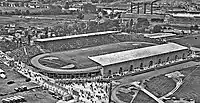 |
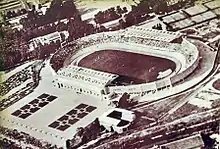 |
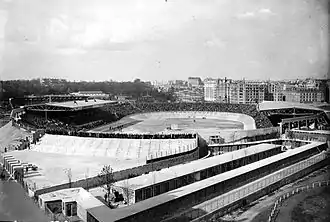 |
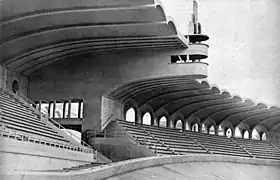 |
| Strasbourg | Le Havre | ||
| Stade de la Meinau | Stade Municipal | ||
| Capacity: 30,000 | Capacity: 22,000 | ||
 |
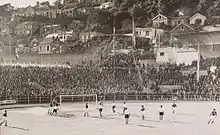 | ||
| Reims | Toulouse | Lille | Antibes |
| Vélodrome Municipal | Stade du T.O.E.C. | Stade Victor Boucquey | Stade du Fort Carré |
| Capacity: 21,684 | Capacity: 15,000 | Capacity: 15,000 | Capacity: 7,000 |
 |
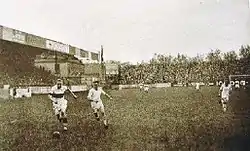 |
.jpg.webp) | |
Squads
For a list of all squads that appeared in the final tournament, see 1938 FIFA World Cup squads.
Final tournament
Bracket
| Round of 16 | Quarter-finals | Semi-finals | Final | |||||||||||
| 5 June – Marseille | ||||||||||||||
| 2 | ||||||||||||||
| 12 June – Colombes | ||||||||||||||
| 1 | ||||||||||||||
| 3 | ||||||||||||||
| 5 June – Colombes | ||||||||||||||
| 1 | ||||||||||||||
| 3 | ||||||||||||||
| 16 June – Marseille | ||||||||||||||
| 1 | ||||||||||||||
| 2 | ||||||||||||||
| 5 June – Strasbourg | ||||||||||||||
| 1 | ||||||||||||||
| 6 | ||||||||||||||
| 12 and 14 June – Bordeaux | ||||||||||||||
| 5 | ||||||||||||||
| 1 (2) | ||||||||||||||
| 5 June – Le Havre | ||||||||||||||
| 1 (1) | ||||||||||||||
| 3 | ||||||||||||||
| 19 June – Colombes | ||||||||||||||
| 0 | ||||||||||||||
| 4 | ||||||||||||||
| 5 June – Reims | ||||||||||||||
| 2 | ||||||||||||||
| 6 | ||||||||||||||
| 12 June – Lille | ||||||||||||||
| 0 | ||||||||||||||
| 2 | ||||||||||||||
| 4 and 9 June – Paris | ||||||||||||||
| 0 | ||||||||||||||
| 1 (4) | ||||||||||||||
| 16 June – Paris | ||||||||||||||
| 1 (2) | ||||||||||||||
| 5 | ||||||||||||||
| 5 June – Lyon | ||||||||||||||
| 1 | Third place | |||||||||||||
| w/o | ||||||||||||||
| 12 June – Antibes | 19 June – Bordeaux | |||||||||||||
| — | ||||||||||||||
| 8 | 4 | |||||||||||||
| 5 and 9 June – Toulouse | ||||||||||||||
| 0 | 2 | |||||||||||||
| 3 (2) | ||||||||||||||
| 3 (1) | ||||||||||||||
Round of 16
| Hungary | 6–0 | |
|---|---|---|
| Kohut Toldi Sárosi Zsengellér |
Report |
| Brazil | 6–5 (a.e.t.) | |
|---|---|---|
| Leônidas Romeu Perácio |
Report | Scherfke Wilimowski |
| Czechoslovakia | 3–0 (a.e.t.) | |
|---|---|---|
| Košťálek Zeman Nejedlý |
Report |
Replays
| Switzerland | 4–2 | |
|---|---|---|
| Walaschek Bickel Abegglen |
Report | Hahnemann Lörtscher |
Quarter-finals
| Switzerland | 0–2 | |
|---|---|---|
| Report | Sárosi Zsengellér |
| Sweden | 8–0 | |
|---|---|---|
| H. Andersson Wetterström Keller Nyberg |
Report |
Semi-finals
Third place play-off
Goalscorers
With seven goals, Leônidas was the top scorer in the tournament. In total, 84 goals were scored by 42 players, with two of them credited as own goals.
- 7 goals
- 5 goals
- 4 goals
- 3 goals
- 2 goals
- 1 goal
- 1 own goal
 Sven Jacobsson (playing against Hungary)
Sven Jacobsson (playing against Hungary)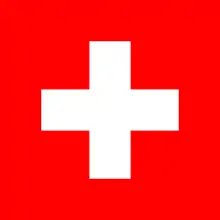 Ernst Lörtscher (playing against Germany)
Ernst Lörtscher (playing against Germany)
FIFA retrospective ranking
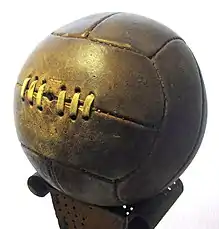
In 1986, FIFA published a report that ranked all teams in each World Cup up to and including 1986, based on progress in the competition, overall results and quality of the opposition.[14][15] The rankings for the 1938 tournament were as follows:
| R | Team | P | W | D | L | GF | GA | GD | Pts. | |
|---|---|---|---|---|---|---|---|---|---|---|
| 1 | 4 | 4 | 0 | 0 | 11 | 5 | +6 | 8 | ||
| 2 | 4 | 3 | 0 | 1 | 15 | 5 | +10 | 6 | ||
| 3 | 5 | 3 | 1 | 1 | 14 | 11 | +3 | 7 | ||
| 4 | 3 | 1 | 0 | 2 | 11 | 9 | +2 | 2 | ||
| Eliminated in the quarter-finals | ||||||||||
| 5 | 3 | 1 | 1 | 1 | 5 | 3 | +2 | 3 | ||
| 6 | 3 | 1 | 1 | 1 | 5 | 5 | 0 | 3 | ||
| 7 | 3 | 1 | 1 | 1 | 5 | 12 | −7 | 3 | ||
| 8 | 2 | 1 | 0 | 1 | 4 | 4 | 0 | 2 | ||
| Eliminated in the round of 16 | ||||||||||
| 9 | 2 | 0 | 1 | 1 | 4 | 5 | -1 | 1 | ||
| 10 | 2 | 0 | 1 | 1 | 3 | 5 | -2 | 1 | ||
| 11 | 1 | 0 | 0 | 1 | 5 | 6 | −1 | 0 | ||
| 12 | 1 | 0 | 0 | 1 | 1 | 2 | −1 | 0 | ||
| 13 | 1 | 0 | 0 | 1 | 1 | 3 | −2 | 0 | ||
| 14 | 1 | 0 | 0 | 1 | 0 | 3 | −3 | 0 | ||
| 15 | 1 | 0 | 0 | 1 | 0 | 6 | −6 | 0 | ||
Footnotes
- Ashdown, John (22 April 2014). "World Cup: 25 stunning moments … No11: Austria's Wunderteam". The Guardian. Retrieved 29 June 2014.
- "History of the World Cup Final Draw" (PDF). Retrieved 26 March 2012.
- Hesse-Lichtenberger, Ulrich (2003). Tor!: The Story of German Football. London: WSC Books. p. 85. ISBN 095401345X.
- Steinberg, Jacob (27 June 2018). "South Korea 2-0 Germany: World Cup 2018 – as it happened". Retrieved 20 September 2018 – via www.theguardian.com.
- Martin, Simon (1 April 2014): "World Cup: 25 stunning moments … No8: Mussolini's blackshirts' 1938 win". theguardian.com. Läst 22 April 2016.
- "Jules Rimet Cup". FIFAWorldCup.com. Archived from the original on 20 March 2007. Retrieved 14 June 2014.
- Sweden were awarded a walkover as Austria were unable to compete because of the Austrian Anschluss in March 1938.
- Actually from Austria, but finally representing the German Football Association because of the Anschluss.
- RSSSF credits this goal as coming in the 90th minute.
- RSSSF credits goal in the 81st minute as coming in the 61st minute.
- RSSSF credits goal in the 80th minute as coming in the 60th minute.
- RSSSF credits this goal as coming in the 89th minute.
- FIFA initially credits this goal to Leônidas, but changed it to Roberto in 2006."Archived copy". Archived from the original on 16 November 2006. Retrieved 5 December 2013.CS1 maint: archived copy as title (link)
- "page 45" (PDF). Retrieved 26 March 2012.
- "FIFA World Cup: Milestones, facts & figures. Statistical Kit 7" (PDF). FIFA. 26 March 2013. Archived from the original (PDF) on 21 May 2013.
External links
| Wikimedia Commons has media related to 1938 FIFA World Cup. |
- 1938 FIFA World Cup France ™, FIFA.com
- Details at RSSSF; note that they often disagree with FIFA on goal scorers and times
